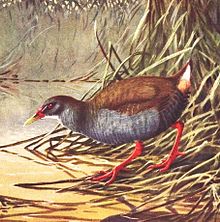Zapata rail
| Zapata rail | |
|---|---|
 |
|
| Scientific classification | |
| Kingdom: | Animalia |
| Phylum: | Chordata |
| Class: | Aves |
| Order: | Gruiformes |
| Family: | Rallidae |
| Genus: |
Cyanolimnas Barbour & Peters, 1927 |
| Species: | C. cerverai |
| Binomial name | |
|
Cyanolimnas cerverai Barbour & Peters, 1927 |
|
 |
|
| Green shows known range | |
The Zapata rail (Cyanolimnas cerverai) is a medium-sized, dark-coloured rail, the only member of the monotypic genus Cyanolimnas. It has brown upperparts, greyish-blue underparts, a red-based yellow bill, white undertail coverts, and red eyes and legs. Its short wings render it almost flightless. It is endemic to the wetlands of the Zapata Peninsula in southern Cuba, where its only known nest was found in sawgrass tussocks. Little is known of its diet or reproductive behaviour, and its described calls may belong to a different species.
The species was discovered by Spanish zoologist Fermín Zanón Cervera in March 1927 in the Zapata Swamp near Santo Tomás, in the southern Matanzas Province of Cuba. The swamp holds one other bird found nowhere else, the Zapata wren, and also gives its name to the Zapata sparrow. Due to ongoing habitat loss in its limited range, its small population size, and predation by introduced mammals and catfish, the Zapata rail is evaluated as critically endangered on the IUCN Red List of threatened species. Tourism and climate change may pose threats in the future.
The Zapata rail was formally described by American herpetologist Thomas Barbour and his compatriot, ornithologist James Lee Peters, in 1927. They considered it distinctive enough to merit its own genus, Cyanolimnas. The genus name derives from Ancient Greek kuanos "dark blue" and Modern Latin limnas "rail or crake"; the specific name cerverai honours the rail's discoverer, Fermín Zanón Cervera, a Spanish soldier who had stayed on after the Spanish–American War and became a professional naturalist.
...
Wikipedia

